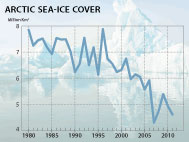| SEARCH |
-

Nov 17, 2015
Reflections on a three-decade legacy
The International Geosphere-Biosphere Programme (IGBP) will come to a close at t...
-
Nov 17, 2015
Use of and access to content on this website
Text and images produced by IGBP in house are free to use with appropriate credi...
-
Nov 12, 2015
Bella Gaia performance and panel discussion to mark IGBP's closure
A musical performance by Bella Gaia will celebrate the achievements and legacy o...
-

Towards Future Earth:
evolution or revolution?
During its three decades of existence, the International Geosphere-Biosphere Pro...
-
A personal note on IGBP and the social sciences
Humans are an integral component of the Earth system as conceptualised by IGBP. João Morais recalls key milestones in IGBP’s engagement with the social sciences and offers some words of advice for Future Earth.
-
IGBP and Earth observation:
a co-evolution
The iconic images of Earth beamed back by the earliest spacecraft helped to galvanise interest in our planet’s environment. The subsequent evolution and development of satellites for Earth observation has been intricately linked with that of IGBP and other global-change research programmes, write Jack Kaye and Cat Downy .
-
Deltas at risk
Around 500 million people worldwide live on deltas, but many of the world's deltas are sinking due ...
-
Climate change: the state of the science
A new data visualization released on the first day of the plenary negotiations at the UNFCCC’s clima...
-
Climate Change:
the State of the Science
Videos now online from the Stockholm public forum to mark the launch of the IPCC's climate report, 2...
Eddy covariance flux measurements with a weight-shift microlight aircraft
Atmospheric Measurement Techniques (2012)
Metzger S, Junkermann W, Mauder M, Beyrich F, Butterbach-Bahl K, Schmid H P and Foken T (2012)
DOI: 10.5194/amtd-5‐2591-2012
Vol 5, pp 2591‐2643

Abstract
The objective of this study is to assess the feasibility and quality of eddy-covariance flux measurements from a weight-shift microlight aircraft (WSMA). Firstly, we investigate the precision of the wind measurement (σu,v ≤ 0.09 m s−1, σw = 0.04 m s−1), the lynchpin of flux calculations from aircraft. From here, the smallest resolvable changes in friction velocity (0.02 m s−1), and sensible- (5 W m−2) and latent (3 W m−2) heat flux are estimated. Secondly, a seven-day flight campaign was performed near Lindenberg (Germany). Here we compare measurements of wind, temperature, humidity and respective fluxes between a tall tower and the WSMA. The maximum likelihood functional relationship (MLFR) between tower and WSMA measurements considers the random error in the data, and shows very good agreement of the scalar averages. The MLFRs for standard deviations (SDs, 2–34%) and fluxes (17–21%) indicate higher estimates of the airborne measurements compared to the tower. Considering the 99.5% confidence intervals, the observed differences are not significant, with exception of the temperature SD. The comparison with a large-aperture scintillometer reveals lower sensible heat flux estimates at both tower (−40 to −25%) and WSMA (−25–0%). We relate the observed differences to (i) inconsistencies in the temperature and wind measurement at the tower and (ii) the measurement platforms' differing abilities to capture contributions from non-propagating eddies. These findings encourage the use of WSMA as a low cost and highly versatile flux measurement platform.
IGBP closed at the end of 2015. This website is no longer updated.
-

Global Change Magazine No. 84
This final issue of the magazine takes stock of IGBP’s scientific and institutional accomplishments as well as its contributions to policy and capacity building. It features interviews of several past...
-

Global Change Magazine No. 83
This issue features a special section on carbon. You can read about peak greenhouse-gas emissions in China, the mitigation of black carbon emissions and the effect of the 2010-2011 La Niña event on gl...
-
INTERGOVERNMENTAL PANEL ON CLIMATE CHANGE:
How green is my future?
UN panel foresees big growth in renewable energy, but policies will dictate just how big.
-
UK:
'The Anthropocene: a new epoch of geological time?'
Royal Society, Philosphical Transactions A




















